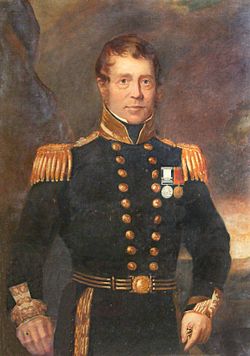John Carter (Royal Navy officer) facts for kids
Quick facts for kids
John Carter
|
|
|---|---|
 |
|
| Born | 1785 Castle Martin, Ireland |
| Died | 2 April 1863 (aged 77–78) Devonport, England |
| Allegiance | United Kingdom of Great Britain and Ireland |
| Service/ |
Royal Navy |
| Years of service | 1798–1863 |
| Rank | Admiral |
| Battles/wars | Battle of Trafalgar |
| Relations |
|
John Carter (born 1785, died 1863) was a brave Admiral in the Royal Navy, which is the United Kingdom's navy. He was an important officer during big wars like the French Revolutionary Wars and the Napoleonic Wars. He was born in Castlemartin, Ireland, and was the son of Thomas Carter.
Contents
John Carter joined the Navy in January 1798. He started his service on a ship called HMS Brilliant. This ship had 28 guns and was sailing in the Mediterranean Sea.
In July, the Brilliant almost got caught by two much larger French ships. These French ships had 44 guns each.
After that, Carter moved to another ship called HMS Penelope. Here, he worked as a midshipman, which is a junior officer. He helped block the port of Malta to stop enemy ships from getting in or out.
Capturing the Guillaume Tell
On March 30, 1800, the Penelope was part of a group of ships that caught a huge French ship called the Guillaume Tell. This French ship had 84 guns!
After this, Carter took part in a big military campaign in Egypt. He also helped in smaller boat fights near the coasts of France and Genoa.
Fighting with Admiral Nelson
John Carter later served on HMS Victory, which was the famous ship of Vice-Admiral Lord Nelson. In February 1805, Lord Nelson made Carter an acting-lieutenant. This meant he was temporarily given a higher rank. He moved to the 74-gun ship HMS Leviathan.
Lord Nelson was so impressed with Carter's service that he gave him his own sword and telescope as a special award.
The Battle of Trafalgar
Carter then joined the chase after the French and Spanish fleets all the way to the West Indies. This was part of the Trafalgar Campaign. He returned with the British fleet and fought in the famous Battle of Trafalgar.
During this battle, his job was to make sure the enemy prisoners were safe. He also helped destroy the captured enemy ships, which were called "prizes."
After the Big Wars
By late 1806, Carter was back in the West Indies. He had to sail a very leaky ship called HMS Cerf back to Britain. He used sails to patch up the holes in the ship's bottom. The pumps had to be worked the whole way to keep the ship from sinking!
In February 1814, he captured a 14-gun ship called the Emille off St Valery. He was promoted to post-captain on December 7, 1815. This was a very important rank.
After the Napoleonic Wars ended, he became the superintendent of the Royal Hospital Haslar. This was a hospital for sailors.
Later Life and Promotions
From December 1841 to December 1846, Carter was the Superintendent of the Royal Clarence Victualling Yard. This was a place where food and supplies for the navy were stored.
He continued to be promoted in the Navy. He became a rear-admiral on April 8, 1851. Then, he was promoted to vice-admiral on July 9, 1857. Finally, he became a full admiral on October 4, 1862.
Admiral John Carter passed away on April 2, 1863, in Devonport.
See also

